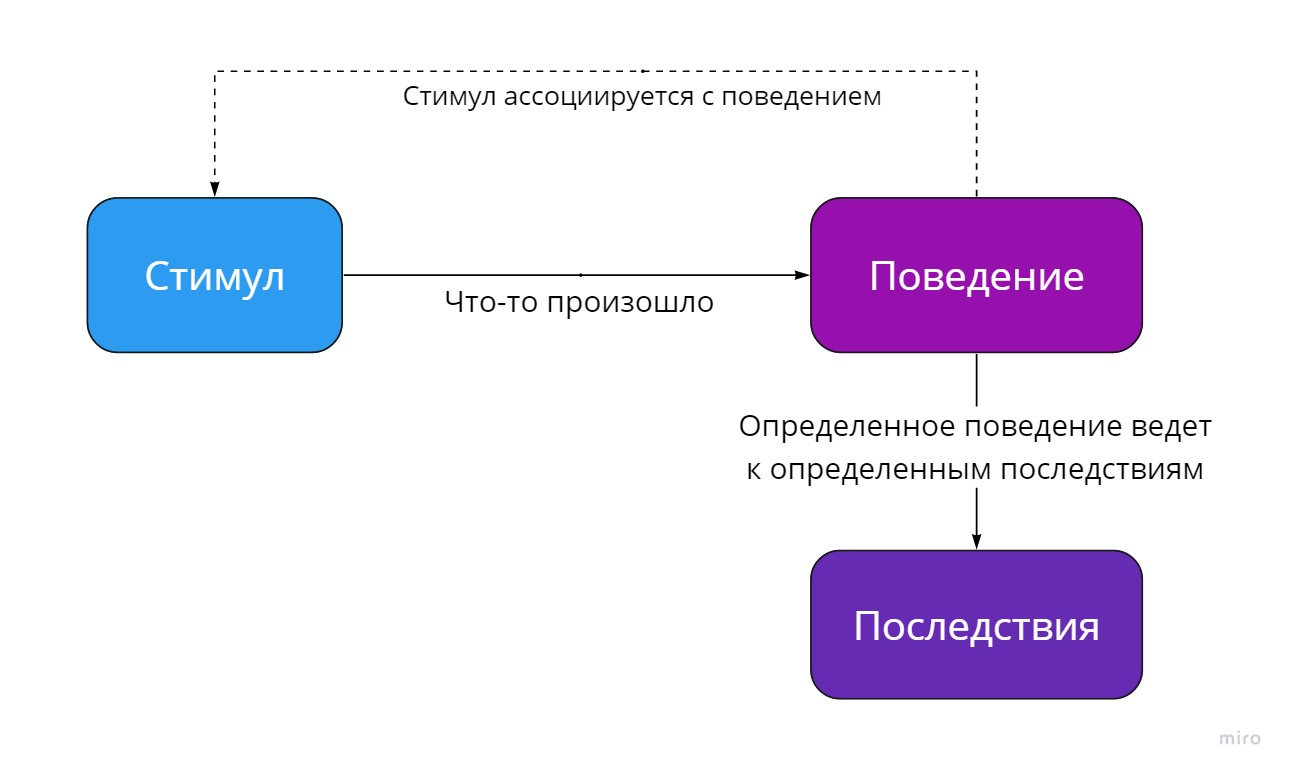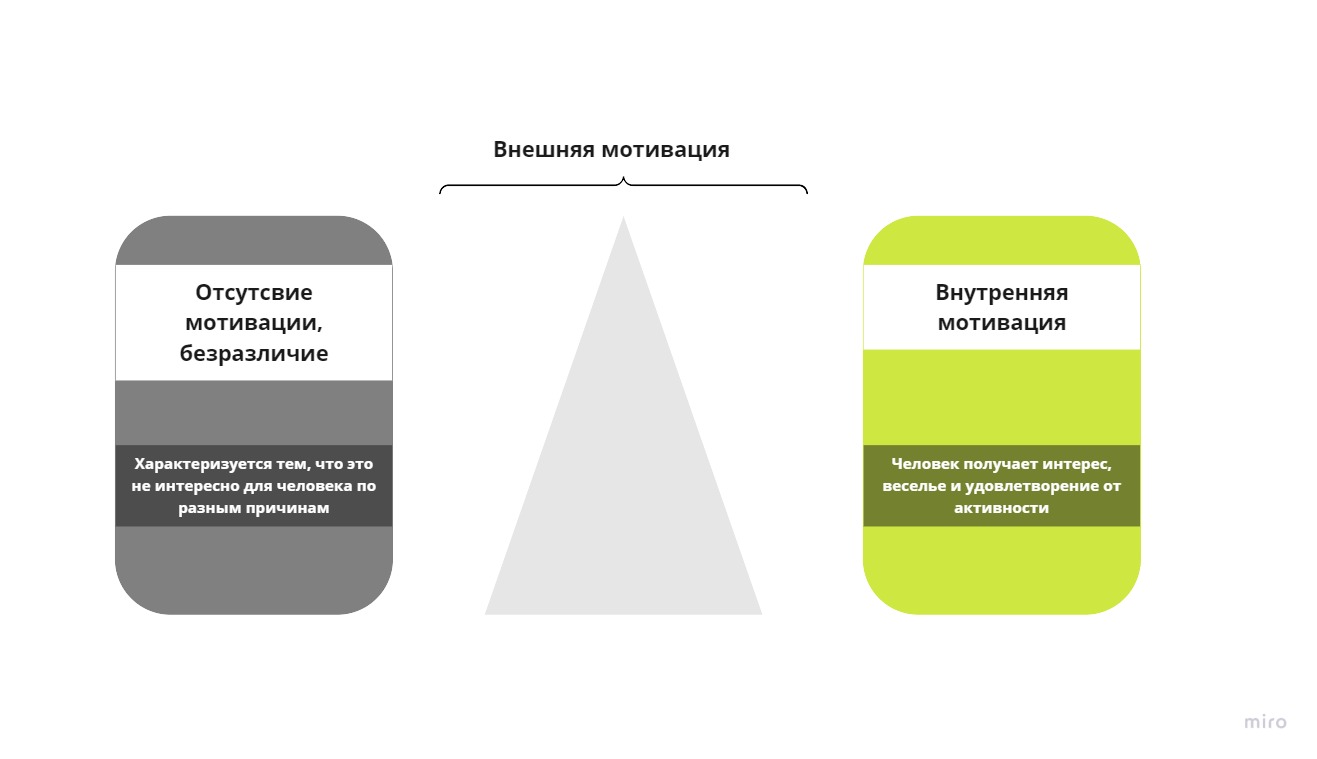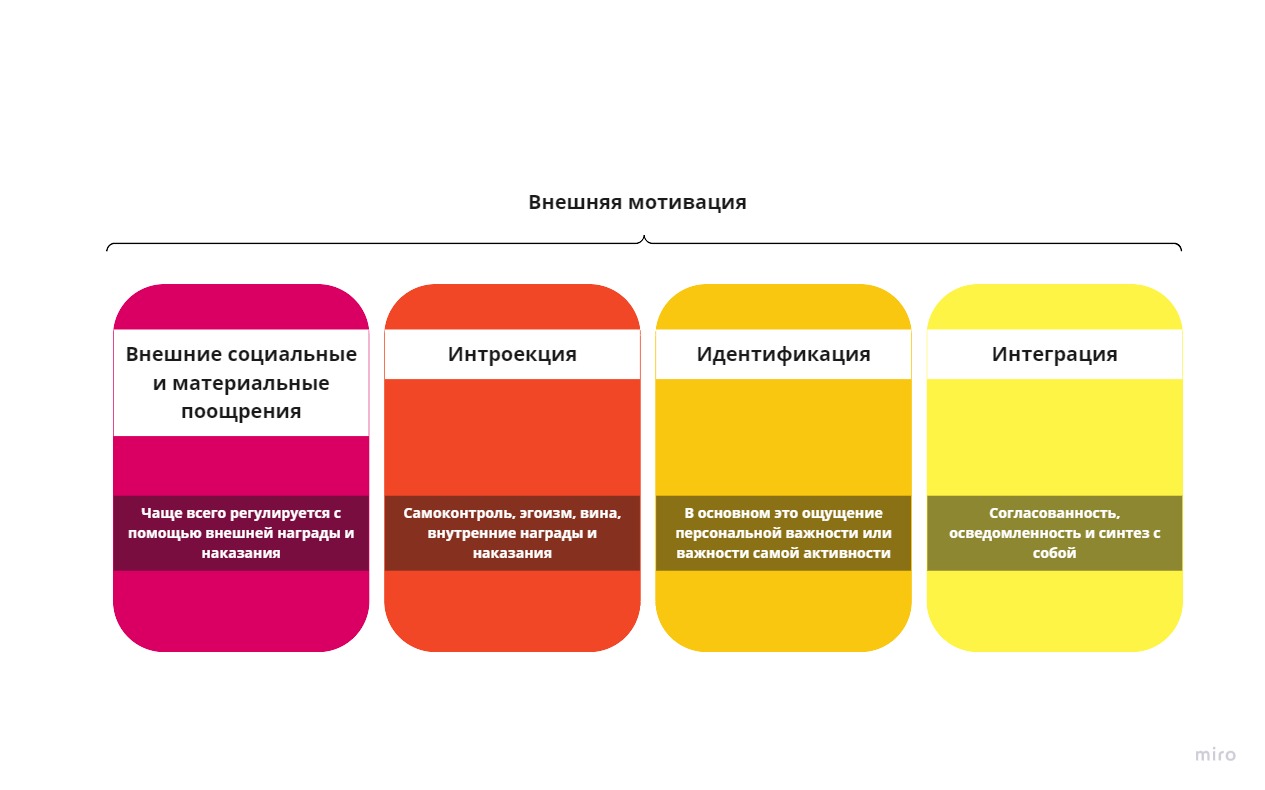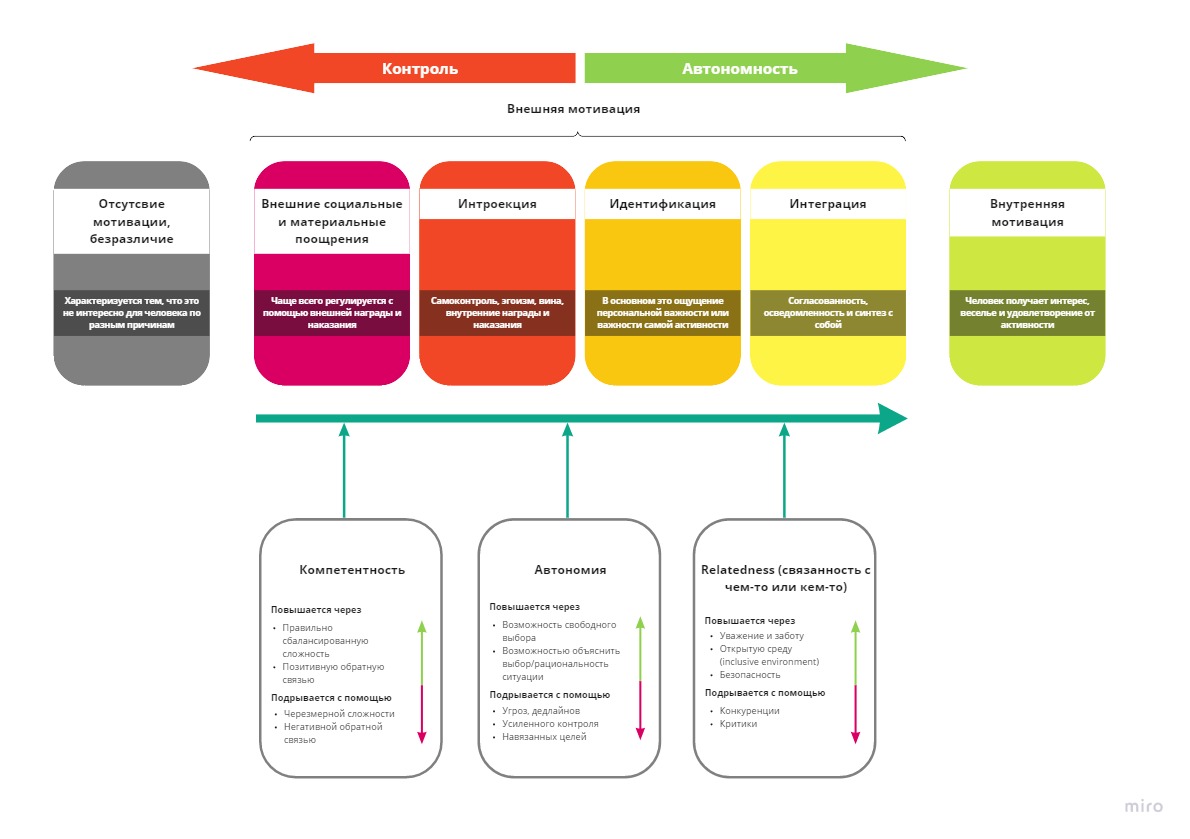
This is the second post in a series in which I talk about gamification and how to apply it in business or personal life.
In the previous post , we talked about what gamification and play are, what atomic elements they consist of. And what better not to do if you create such systems for the first time.
In this article I will talk about motivation and what are the approaches to managing motivation both for personal purposes and when creating products.
To make good products, you need to understand the motivation of the people who will use those products. Over the past 200 years, people have come up with many frameworks for explaining motivation. I will only talk about two of them, Behaviorism and Cognitivism.
Behaviorism and Cognitivism
To put it simply, there are two main areas of understanding of behavior.
Where behaviorism says that you need to look at the behavior of the individual.
For example, one of the definitions - methodological behaviorism - states that only public events (the behavior of an individual) can be objectively observed, and, therefore, personal events (thoughts and feelings) should be ignored.
Cognitivism , on the other hand , focuses more on mental models and on what happens inside the consciousness of the individual. Cognitive science emerged as a response to behaviorism in an attempt to find a new approach to understanding human consciousness.
Both of these areas are used in the creation of gaming systems, so it is worth studying them in more detail.
Behaviorism in detail
The main concept in behaviorism is behavior. And behaviorism speaks of influencing behavior through stimuli.
Stimuli are something that influences the individual from outside. This could be the smell of food or a light source.
And the idea is that stimuli become associated with behavior. We got an incentive, something happened, and we got behavior.

But any behavior always has consequences.

In behaviorism, these consequences are called positive or negative reinforcement.
You take action, and either something good happens - you get food, money and other rewards. Or, after your action, something bad happens and you get punished.
As a result of the consequences, you change your behavior to minimize negative consequences and maximize positive ones.

When you observe the consequences a number of times, then associations are created for you. You start doing things differently. This is what the learning loop is.
What lessons can be learned from Behaviorism?
The first is observation . We have to look at what people are actually doing. If people react in a certain way to a stimulus, then we, as creators of game systems, must also learn something from the process of observation.
The second is the importance of feedback loops . When a user of the system sees timely feedback on his behavior, he learns faster and understands what actions are allowed and desirable, and what is better not to do.
And finally, reinforcements... Learning happens when you see that a certain action or stimulus leads to a certain action. The more stable a certain result appears after a certain action, the stronger connections will be formed in the brain between these two things. And this is an important lesson in behaviorism about how to motivate and reward certain actions.
The second and third points are important because our brain is the mechanism for recognizing patterns. And in this machine, dopamine is not given out as a reward, but in the process of waiting for a reward. When we realize that the reward is coming, that's when we get our dose of dopamine. This means that if you are developing a gami ed, behavioral form where it is all about rewards, then you have to help people anticipate those rewards. Otherwise, users will not have feedback on whether they are moving correctly.
Dangers of Behaviorism
It is an effective tool for manipulation.
The problem is that companies and products often use knowledge of psychology and motivation to manipulate, namely to create the illusion that certain actions that bring money to the company will also be beneficial for the user or employee.
But people feel when they do something against their will. Subsequently, this will cause negative feelings towards the company.
At first, these will be negative reviews about the company or product, which will affect both the difficulty of attracting good specialists to the company and the very economy of the product.
With a large number of complaints, the state can pay attention to you and take over your regulation, which will also add problems.
But the biggest problem is that the team loses focus and starts thinking about how to trick the user and raise metrics in the short term, without thinking about where it will lead in a few years. A good example is the story of loot boxes in SW: Battlefront.
After all, the main goal of the company is to cover needs and satisfy its users.
Hedonic Treadmill
This is the name of the second problem in the behaviorist approach.
It is that as you start giving people rewards to reinforce the feedback loop, you will need to give more and more to achieve the same effect.
And, if you once gave a reward for performing a certain action, then be prepared for the fact that next time this person will no longer want to perform this and similar actions without a reward.
Excessive emphasis on status
The cheapest way to engage users in a product is to create a status.
Platinum airline cards, leaderboards, and beautiful car and phone numbers are one example of this status.
A user for whom such tools work will bring the company a lot more money compared to a user who is not interested in a status upgrade. But if we look at the number of users who are interested in obtaining a status, we will see that they are often much less than people who are not interested in status.
But the company will focus specifically on those who like status, thereby making the wrong strategic decision and losing most of the remaining customers. Lose those who actually generate the main profit.
Internal and external (Intrinsic and Extrinsic) motivation
An alternative to the behavioral approach in psychology is cognitivism. It aims to open a black box, find out what is actually going on in a person's head and what prompts people to behave in a certain way.
This approach is based on the division of motivation into two categories.
The first category is intrinsic motivation , which means that you do it for yourself. You do this not because of external stimuli, but because you want to do it. You find this activity exciting, fun and interesting.
The second category is extrinsic motivation.... And it means that you are doing something for an external reason, not because you like it. It could be money, luck, fame, or status. Perhaps someone important to you asked you to do this. This can be a family member or your boss. Whatever the reason, you are doing something for the reward itself, not because you enjoy doing it.
A look at extrinsic motivation through SAPS
Gabe Zichermann , who is a gamification consultant, has proposed four different categories of reward, which are predominantly different kinds of extrinsic reward:
- Status
- Access
- Power
- Stuff
And it's a useful tool when you need to come up with a reward to motivate your users externally.
- — (status). - , , . . , .
- — (access). , , . . OZON OZON Premium, .
- — (power), . — - .
- , -, (stuff). , .
In Gabe Zichermann's articles, these categories are arranged in a hierarchical order. This means that it is more profitable for companies to embed status in a gami ed system than stuff , because it is banally cheaper.

When you give people stuff , you are giving away things that actually cost you money. When you give people status , you are giving them intangible rewards that are worthless.
And another feature of SAPS is that the elements are already arranged in the order of their power of influence on the player. This is a controversial issue, in which it all depends on the significance of the status or physical rewards for the player.
So SAPS already ranked for companies developing gami ed systems in terms of efficiency and implementation cost.
Rewards can be demotivating
The problem with rewards is that rewards can make you less motivated to do something that you previously did without a reward. Sounds counterintuitive, but supported by a lot of research.
Take an example of an English word learning app. At first, you liked just learning words. But in the next update, the developers added a leaderboard, which includes those who learn the most words per day. And then your motivation is replaced from internal (intrinsic) to external (extrinsic). You are now focused on gaining status and feel guilty about finishing last. You no longer enjoy simple vocabulary learning and will soon abandon this app.
It is important to be able to present rewards
Understanding how to properly present and motivate rewards will help you create a great product that engages and engages users.
For example, material rewards (stuff) motivate the least. They are the maximum degree of extrinsic motivation. If you decide to give the player something of value in exchange for his activity, then this will be the greatest risk of replacing internal motivation with external one.
But there is good news too. If you give out an award unexpectedly , as a small reward for good work, then this should not affect the person's motivation. Because he did something based on intrinsic motivation, and the reward was just a nice bonus that this person did not expect.
Self-determination theory
Since 1970. Edward L. Desi and Richard M. Ryan, two American psychologists at the University of Rochester, created the framework for self-determination theory, a comprehensive theory of human motivation. Through a large number of experiments, this theory has shown that people can be motivated by rewards. But intrinsic motivation is much stronger than extrinsic motivation that inspires people to do something.
According to the theory of self-determination, people have a range of types of motivation.
On the left side of the spectrum is Amotivation . This means that you have no motivation at all to perform this activity. This is indifference and unwillingness.
On the other side is intrinsic motivation .

And in the center of the spectrum isextrinsic motivation , which is divided into 4 subtypes.
These subtypes differ in the degree of freedom of the individual to perform an action.

External regulation (external social and material incentives) is the closest subtype to Amotivation . This motivation is applied when a person does not want to do something, but must. Due to external reasons. The simplest example is an uninteresting job for which a person gets paid. This does not mean that this type of motivation is good or bad. But with this motivation, the person will complete the task with the minimum effort required to receive the reward.
Interjection... In psychology, this word refers to an unconscious psychological process in which we include in our inner world the motives and attitudes of other people. One of the mechanisms of psychological defense.
In self-determination theory, this term means that we take external motivation and make it our own. The source of motivation for behavior is guilt, anxiety, or shame. An example of introjection motivation is a person who goes to church every Sunday because he is afraid of anger from above or the negative reaction of his acquaintances if he does not attend a church event. This motivation is best avoided because it is anxiety-provoking. So motivated people find it difficult to feel confident and positive about their actions
IdentificationIs when we take extrinsic motivation and make it our own. This is not only for the sake of status, but more about the fact that it is useful.
With this form of motivation, the person does not get pleasure from action or quick rewards. But he is also not motivated by feelings of guilt or shame: he believes that this action is useful for his development and accepts this behavior as his own.
For example, a person does not like mathematics but studies it, because it will be useful to him for his future career.
4. And finally, the closest subtype to intrinsic motivation is integration... This form of motivation occurs when a person has completely integrated external motivation with his own. He carefully studied external motives and decided that they were consistent with his personal beliefs and values. An example would be someone who volunteers at church. He believes that this act is consistent with his personal belief system. He does not feel guilt or shame when he does not attend church - he goes there because he feels it is right for him.
And at the very end of the spectrum is intrinsic motivation . At this stage, activities do not waste motivation, but energize you. You are interested in doing this, you are having fun and you are having fun.

So, each of these types of motivation can be applied to create products and gami ed systems. Ideally, all activities of such systems should be in the block of intrinsic motivation. And it should be authentic, people should really love to do it.
How to increase the intrinsic motivation of an individual?
In the theory of self-determination, there are three basic needs for creating the conditions that are necessary for the emergence of intrinsic motivation.

The first need is competence . Understanding that the problem can be solved. People feel that they are doing something important, solving problems, overcoming obstacles. They achieve something by performing certain activities.
The second is autonomy , which indicates that a person feels that everything is under control. It is he who makes the choice. It is not someone else who tells him to do something, but he does it at his own discretion.
And the third basic need is relatedness (connectedness with something or someone)... In this case, activities are associated with something external. It could be some sense of meaning or purpose. Someone might be using less electricity because that's good for the planet. Or I do it because it will help my company and I believe in my company and want to be a good team player in the organization. Or I do it with friends. Social interaction is an element of kinship that we often see in games.
As a result, Self-determination theory turns into a scheme that can be opened with a high-resolution picture.

From left to right, the types of motivation I described above are shown.
The green arrow shows the increasing power of motivation. And under this arrow are three basic needs of the individual. The better the basic needs of the individual are covered, the more to the right on the scale his motivation will be located.
Total
Help people achieve their goals by creating autonomy. Give them a chance to solve problems on their own and invite them to participate in decision making. This tip works for parents, executives, and anyone looking to create good products.
Excessive pressure and nurturing suppresses interest in research, curiosity, creativity, and risky spontaneous decisions.
By understanding the basics of motivation, you can guide people, and you can manage them.
It's always up to you.